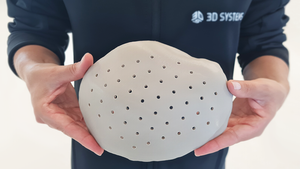April 15, 2003
 Understanding Thermoplastic Elastomers
Understanding Thermoplastic Elastomers
by Geoffrey Holden
With the rapid expansion of the market for thermoplastic elastomers and the large number of materials available, it is difficult for the engineer to keep up with the latest advances and applications for these materials. This book provides “a short introduction and overview of the whole field†of thermoplastic elastomers and is a valuable learning tool for anyone using them.
The first chapter is a brief introduction and historical survey of thermoplastic elastomers. The next chapter classifies the available materials into seven groups and summarizes the physical characteristics common to all of the classes—that is, what makes these materials behave as elastomers? The next four chapters provide a detailed examination of the classes of materials.
Chapter 3 on styrenic block copolymers is the most extensive and deals with the domain theory of these materials, the effects of fillers and styrene/elastomer ratios, miscibility with other polymers, and the thermodynamics of phase separation. It also describes the polymerization methods used for each type of block copolymer.
Chapter 4 describes the multiblock copolymers derived from polyurethanes, polyethers, polyamides, and polyolefins. The first three are treated as a group due to the common polymerization methods involved, followed by discussion of the different monomers used and their effect on the properties of the final product. For the polyolefin materials, the segmental structures, polymerization methods, and monomers involved are covered in detail.
Chapter 5 deals with hard polymer/elastomer combinations, which include thermoplastic vulcanizates. These materials are blends in which the hard polymer is mainly polypropylene mixed with an elastomer phase. In the case of thermoplastic vulcanizates, the blend is then dynamically vulcanized. The molecular requirements for obtaining an elastomeric material are reviewed along with the effects of different elastomer phases and dynamic vulcanization.
Chapter 6 presents the lesser-used materials: graft copolymers, ionomers, and core-shell morphologies. These materials are treated rather briefly due to the lack of scientific investigation in these areas.
The seventh chapter discusses the commercial applications of the different classes of thermoplastic elastomers. This includes compounding similar to conventional vulcanized elastomers, blends with other polymers, and uses as sealants and adhesives. The last chapter lists some of the economic aspects, trade names, and a glossary.
Understanding Thermoplastic Elastomers is an excellent introductory text for anyone wishing to learn the basics of thermoplastic elastomers. It is well written, well organized, and easy to understand if the reader can recall some chemistry. Although it is not as in-depth (nor meant to be) as Holden’s other works, this book is valuable as a first step to becoming familiar with the expanding field of thermoplastic elastomers.
Holden, Geoffrey. Understanding Thermoplastic Elastomers (2000), 110 pp., figures, tables, references, index, $34.95.
 Design Formulas for Plastics Engineers
Design Formulas for Plastics Engineers
by Natti S. Rao
Find all the formulas you need to generate or modify programs in one place.
Published in 1991, Design Formulas for Plastics Engineers is 135 pages of what the author considers to be the most important mathematical formulas for plastics engineers. Natti Rao spent many years as an R&D engineer in the polymer field for BASF AG, and during that time he tested formulas while solving practical problems. As the preface states, this book is more of a summary of these formulas than a handbook.
Design Formulas for Plastics Engineers contains a table of contents, an index, and a list of literature at the end of each chapter pertaining to the formulas presented in each. Numerous problems thoroughly worked out in metric units appear throughout the book.
The books reviewed here and others are available through the IMM Book Club. Contact Sherrie McRae at (800) 655-3330, e-mail [email protected], or visit www.immbookclub.com. |
The first chapter, Formulas for Rheology, includes ideal solids, Newtonian fluids, viscous shear flow formulas, viscoelastic behavior of polymers, the Maxwell Model, and formulas for die swell and extensional flow. Next, specific volume, specific heat, enthalpy, and thermal conductivity formulas are covered in Thermodynamic Properties of Polymers. The chapter on Formulas for Heat Transfer includes steady-state conduction, unsteady-state conduction, heat conduction with dissipation, dimensionless groups, heat transfer by convection, heat transfer by radiation, dielectric heating, and Fick’s Law of Diffusion. Formulas used to calculate the strength of polymers, part failure, and time-dependent deformational behavior can be found in the chapter Designing Plastics Parts.
By far the longest chapter is Formulas for Designing Extrusion and Injection Molding Equipment. This chapter presents formulas to calculate pressure drops, the conveying of solids, the melting of solids, melt conveying, temperature fluctuation of melt, screw parameters, filling of mold, cooling of melt in mold, flowability of injection molding resins, and many more formulas to help the engineer.
This book is a summary of formulas rather than a handbook. |
The formulas in this book are not new, but you can now find all these formulas in one place, in one book. The preface says it best: “The plastics engineer often has to deal with different fields of engineering. The search for the appropriate equations in the various fields concerned can be time-consuming. A collection of formulas from the relevant fields, as given in this book, makes it easier to write one’s own program or to make changes in an existing program, in order to obtain a better fit with the experiments.â€â€”Reviewed by Aric Parent, Production Estimator, United Plastics Group, Anaheim, CA, [email protected]. Rao, Natti S. Design Formulas for Plastics Engineers (1991), 135 pp., $34.95.
You May Also Like


